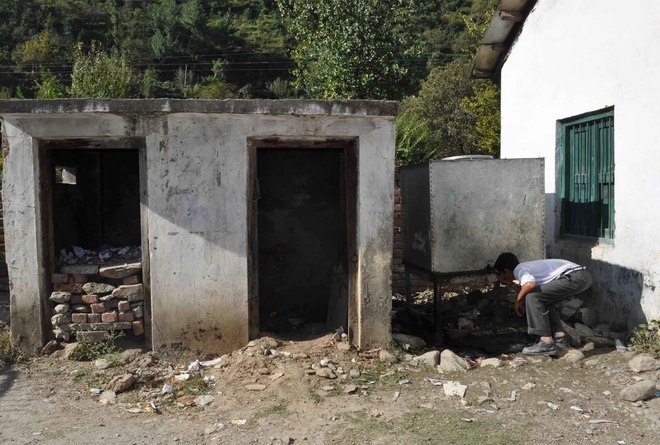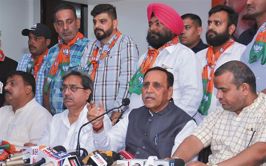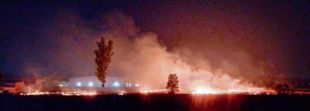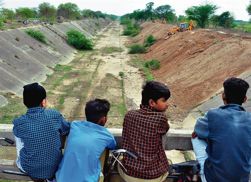
A student drinks water from a tank adjacent to a toilet in a school at Mandi. Photo: Jai Kumar
Bhanu P Lohumi
Tribune News Service
Shimla, June 28
A frightening scenario stares Himachal in the face as enrolment in government elementary schools is decreasing by 5 per cent annually and there are reasons to believe that education will slip out of the hands of the government if downtrend is not arrested
Irrational deployment of teachers, lack of will to formulate a consistent and non-discriminatory policy for recruitment of teachers and collapse of inspection system have become a bane of education in the state, leading to decline in learning standards.
The government has been opening schools without assessing the need and in spite of opening 10,729 primary and 2,291 upper primary schools, the enrolment ratio between government and private schools, which was 89.66 per cent and 10.34 per cent in 2003-04, has been reduced to 58.15 per cent and 41.85 per cent in 2014-15.
While the total enrolment at the elementary level in all schools was 10,89,609 and the share of government schools was 9,33,925 in 2004-05. But it came down to 5, 85,644 in 2014-15 against the total enrolment of 9,58,731.
U-DISE report’s claim
As per the U-DISE report for 2014, there has been an average 5 per cent shift from government to private schools every year and if this continues, the projected percentage of students in government and private schools will be 33.81 per cent and 66.19 per cent in 2024-25.
Even the comparative survey made by the Annual Status of Education Report (ASER) has revealed that the percentage of students in private schools has increased from 19 per cent in 2006 to 35.2 per cent in 2014 while the percentage for boys and girls has increased from 21.8 to 39.3 and 15.9 to 30.7 per cent.
CCE system a failure
“With the scrapping of Class V and VIII board examinations and introduction of the continuous comprehensive evaluation (CCE) system, there are no failures in any class and the new system has led to casual approach among students resulting in sharp deterioration in quality of education” says state president, Himachal Pradesh Government Teachers Union, Virender Chauhan. Moreover, the teachers appointed on an ad hoc basis are assigned a number of non-teaching assignments, increasing the work load, he said, adding that the merit-based regular recruitment through the commission should be made to ensure that cream enters the education sector.
100 pc enrolment
Another trend emerged in the census report is that the population of children in the 0-14 years age group, which was 18,89,000 (31.1 per cent) in 2001, has been projected at 14,98,000 (19.8 per cent) in 2026. Even in the 2011 Census, Himachal has shown the negative growth in 0-6 age group and the population size was 7,77,898 as compared to 93,137 in 2001.
Statistically, Himachal has done quite well in opening schools and achieved nearly 100 per cent enrolment and nearly zero dropout rates at the elementary level and pupil teacher ratio was 1:13.09 at the elementary level.
Stress on improvement
At the primary level, which is the foundation stage, students should be imparted quality education to build a strong base as it will automatically bring qualitative improvement in secondary and higher education, says Prof Shyam Sunder, former Director of Education, Himachal. There is no point in opening more schools and the stress should be on improvement in teaching at the school level for laying strong foundation for skill and talent development, he added.
As per the data provided by the government in the last Assembly session, 943 primary schools have only one teacher, 6,570 schools are managed by two teachers, 1,911 with three teachers and only 1,232 schools have four teachers. On the contrary, 411 schools have less than five students and 35 schools have only one student and teacher pupil ratio is 1:1 in 21 schools while 14 schools have two teachers for one student.
No change in policy
While the government had been talking of rationalisation of teachers for the past two decades, nothing has changed and Chief Minister Virbhadra Singh, who also holds the education portfolio, said schools would be opened to ensure that no
child was required to trek more than 1.5 km distance for elementary education, irrespective of strength
of students.
Fix responsibility
A teacher Surender Chauhan said the pleasing policy of the government was responsible for deterioration of quality in education and said accountability and responsibility of teachers should be fixed.
Teachers are also up in arms against the policy of the government to punish teachers for poor results and maintain that the responsibility of teachers is to ensure that there is no deficiency in teaching and it is the responsibility of the government to provide course books on time and hold regular inspections. “The practice of surprise inspections to check the performance of teachers and students have collapsed and stress on result is resulting in menace such as copying, said a retired teacher Subash Chand.
Condition of schools
Seven government primary schools are without a room, 325 schools have one room, 2,934 schools are running in two rooms, 4,028 in three rooms, 3,305 in four to six rooms and only 110 schools have seven to 10 rooms as per the report of the DISE for 2014. In upper primary schools, 183 are running in one room, 256 schools in two rooms, 1,347 in three rooms, 394 in four to six rooms and only 16 schools have seven to 10 rooms. The normal room requirement of any primary or upper primary room is minimum six to eight rooms.
The learning standards are so poor in the state that only 71.5 per cent students of Class V could read the text of Class II level. Only 47 per cent students of standard V were able to do simple division, 39 per cent students of standard IV could not do subtraction. About 12 per cent students of standard II could not read even letters while 17.2 per cent could not read words.
DirectorSpeak
However, Director, elementary education, RK Purthy maintains that to improve quality, major initiatives such as implementation of learning indicators for Class I to VIII (class and subject wise) are being taken from the current academic year.
In a bid to improve the system, the state government has initiated the process to convert three government primary schools in the Dharampur education block of Mandi district into a model school to be run under mode with the support of a local society.
Textbooks for primary classes have been revised, early reading, writing and numeracy programme initiated for Class I and II for which one teacher from every primary school has been trained, he said, adding that evaluation of students was being done for timely remediation for improvement as per the need of individual child.
A ray of hope
Last but not the least is the problem of deterioration in quality of teacher education which has aggravated with the opening of 75 B.Ed colleges in the private sector and students are getting degrees in 8-10 months. Now there is hope as the National Council of Teachers Education has provided for a two-year B.Ed course which will provide better teaching skills among teachers.



























